Barrier-free Cleveland is a new initiative aimed at eliminating barriers to everyday life for people with disabilities. The CUDC has partnered with Cleveland State University, DigitalC, and HRS Consulting on this project, with major support from The Cleveland Foundation.
61 million adults in the US live with a disability. That’s one in four people nationwide. This can include physical and mobility challenges, vision and hearing impairments, and conditions of neurodivergence, such as autism.
Source: Centers for Disease Control and Prevention
Barrier-free Cleveland will explore best practices in accessible design, assistive technologies, and programs aimed at improving access and eliminating barriers for all people. We’re taking a close look at two Cleveland neighborhoods—Clark-Fulton and Midtown/Hough. Both of these neighborhoods are developing new neighborhood plans and our goal is to align accessibilily recommendations with the priorities that emerge from these plans. This process will lead to a set of Barrier-free Cleveland guidelines for these two neighborhoods, but that also could apply to other neighborhoods in Cleveland and beyond.
The Americans with Disabilities Act was adopted by the federal government in 1990—30 years ago! Curb cuts, ramps, paratransit, and other accessibility improvements across the country came about because of this important legislation. But there is more work to do.
In 2019, the CUDC assisted North Coast Community Homes with ZeroThreshold, an international design competition for new ideas in accessible, affordable housing. The competition took a design-forward approach to accessibility, giving equal weight to aesthetics and function. Entries encompassed new construction, the retrofit of existing housing, accessible public space design, and holistic urban design strategies aimed at eliminating physical and social barriers.
Barrier-free Cleveland expands the scale from housing to neighborhoods, seeking new design approaches that enable all residents to reach neighborhood destinations, enjoy public spaces, and have full access to transit and transportation. The project team is assembling case studies from throughout the US and around the world, identifying best practices in urban design, assistive technologies, and programming to expand access for all.
We are conducting Accessibility Scavenger Hunts in the Clark-Fulton and Hough/Midtown neighborhoods in November, working with residents to identify barriers in their communities. We will also be conducting one-on-one interviews in an effort to understand the barriers to mobility that some residents face. Interviews will take place Novermber 2020 - January 2021, We will then draft a set of guidelines for addressing these barriers. The guidelines will be developed in conversation with community stakeholders and incorporated into other community planning and development efforts.
If you are interested in this work, please join us for an Accessibility Scavenger Hunt or contact us to schedule an interview. For more information, email barrierfreecle@kent.edu or call 216.357.3434.















![Domino Park, Brooklyn, NY: social distancing circles. [img: Marcella Winograd]](https://images.squarespace-cdn.com/content/v1/56f9538fd210b8d37ef6d7a8/1600864529193-FTB0376LMCD196VJKURL/domino_park.jpg)

















































